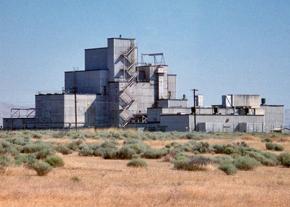Paying for Hanford’s toxic legacy
reports on a recent emergency at the Hanford Nuclear Site and the history of malign neglect that endangers every worker in the area.
THE HANFORD Nuclear Site in eastern Washington--once called "the most toxic place in America"--declared an emergency after the partial collapse of a tunnel containing radioactive material on May 9.
The more than 3,000 workers nearby were initially instructed to shelter in place and not drink any food or water, though Hanford management maintained that no contamination was detected as result of the collapse. By May 11, the hole was backfilled with soil, and most employees were back to work.
The problem, however, is far from solved. The state issued a legal order on May 10 demanding a longer-term solution to protecting the 360-foot tunnel, which feeds into the now-defunct plutonium-uranium extraction (PUREX) complex.
This plant processed more than 70,000 tons of uranium fuel rods between 1956 and 1988. In the 1960s, rail cars containing contaminated equipment were shoved into the tunnel and left. A second tunnel was later constructed for the same purpose.
PUREX is just one plant in the sprawling Hanford site, which was established in 1943 to process nuclear weapons for the Manhattan Project. Plutonium from Hanford was used in the first nuclear test bomb and the atomic bomb detonated in Nagasaki.

The site shut down in the 1980s and the Department of Energy (DOE), through a private contractor, Washington River Protection Service (WRPS), is now in charge of "managing a $110 billion cleanup of 56 million gallons of chemical and nuclear waste, stored in 177 underground tanks--a task that's expected to last the next 50 years," according to NBC News.
One problem, though: The tanks are leaking now.
WHILE NOT as deadly, widespread and immediate as the devastation in Hiroshima and Nagasaki, the operation of and cleanup at Hanford represent a slow-moving nuclear disaster for humans and the environment, with no end in sight. The tunnel collapse was just the most recent in a long line of examples.
Last spring, following a catastrophic leak in a tank, more than 50 workers sought medical attention after being exposed to toxic vapors on the job, causing symptoms such as headaches, dizziness, nausea and burning nose and throat.
The long-term impact of such exposure is much worse. After working at Hanford for 33 years, Abe Garza "has permanent lung damage and brain damage from exposure to toxic chemical vapors at the jobsite. On some days, the gasping for air and coughing is so violent he passes out," according to a KING 5 News report.
Garza is one of countless employees--and the family members of deceased employees--who have spoken out over the years. But the DOE and WRPS have a long history of cutting corners on safety, ignoring and lying about the hazards, and retaliating against whistleblowers.
Last fall, the Washington attorney general's office, along with Local 598 of the pipefitters union and the advocacy group Hanford Challenge, filed a legal challenge to the DOE and WRPS for their abuse of worker safety, including the decision to downgrade the use of respiratory equipment just two weeks prior to dozens of workers being hospitalized due to toxic vapors last spring.
"It makes you angry that they're using you as a piece of cord wood, you're just a number, a rock, a brick," Steve Ellingson, who after 24 years working at Hanford has to use a rescue inhaler four times a day to open his lungs, told KING 5. "You're just a piece that they use until you're not good to them anymore."
It's not just Hanford workers who are jeopardized either. For years, the plant used the Columbia for cooling and dumping its waste, with devastating impacts on the salmon population.
The latest tunnel collapse was also a reminder of much worse damage that could take place in the event of an earthquake, which could cause destruction and evacuation for hundreds of miles. "We know that the earthquake is coming," said state Rep. Gerry Pollet. "And every year it hasn't happened, we've gotten off, like winning the lottery."
The same week as the tunnel collapse, a new report came out about the impact of the earthquake-caused Fukushima nuclear disaster, which concluded that it hit every single person on the planet with a dose of radiation. The dose for most people outside the area was too low to cause sickness--about equivalent of an X-ray--but more troubling is the potential impact on oceans and wildlife.
All this should be a stark reminder that nuclear power should in no way be considered "clean energy," and in the face of Trump's recent belligerence, that the impact of nuclear weapons extends far beyond the blast zone. It's long past time we put the health of people and the planet first.


